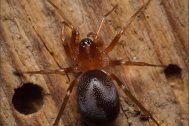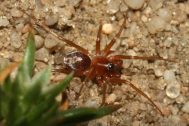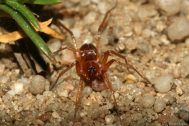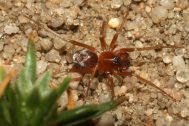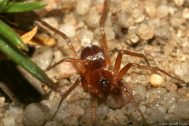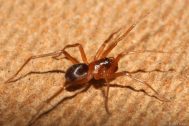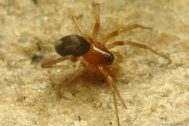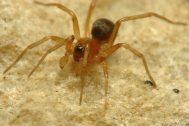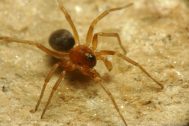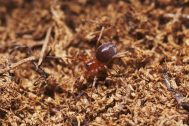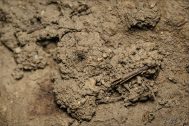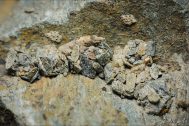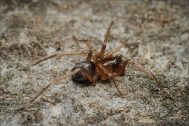Kvadráty: 5852 5653 5761 5652 6059 5752 6766 5648 5863 7161 7162 5759 6161 7164 6159 5755 5547 6471 6061 5862 5853 7266 7165 6765 5751 5350 6967 6474 6368 7066 7267 6670 5552 7065 6569 7069 6469 5746 7168 5850 7171 6570 6970 7063 6372 6175 5954 5446 6663 5854
| Nálezy podle období | |||||
|---|---|---|---|---|---|
| Zodariidae | 0-1900 | 1901-1950 | 1951-2000 | 2001+ | ∑ |
| Zodarion rubidum Simon, 1914 Není ohrožený | 21× | 124× | 145× | ||
Zodarion rubidum Simon, 1914
| České jméno | mravčík skalní |
|---|---|
| Stupeň ohrožení | Není ohrožený |
| Nálezy | 145 nálezů, 50 kvadrátů |
| První nález |
1979, A. Kůrka, Kůrka 2000b |
| Poslední nález | 2024 , Petr Veselý |
| Areál rozšíření | European - ME |
| Fytogeografická oblast |
|
| Původnost stanovišť |
|
| Vlhkost stanovišť |
|
| Stratum |
|
| Osvětlení stanovišť |
|
| Hojnost výskytu |
|
| Nadm. výška | 150-500 |
Literatura
Ant‐eating spider maintains specialist diet throughout its ontogeny.
Predators should be selected to maximize their fitness by catching the most profitable prey. As predators grow in size, they often shift their preferences to larger prey during the course of development. Alike generalist predators, specialized predators should also shift to larger prey within the pool of focal prey. Here, we have studied the natural diet of a specialized ant‐eating spider Zodarion rubidum by means of molecular methods. We tested the hypothesis of a trophic shift during postembryonic ontogenesis and if there is a difference in the diet between sexes due to sexual dimorphism. In addition, a feeding trial was performed to estimate the time at which prey DNA can be detected. The diet of all stages consisted solely of ants (nine genera), thus confirming their strict ant specialization. There was no shift in prey size or prey type during ontogenetic development, but the diversity of prey declined with age. In adult males, very few prey were detected. The feeding trial showed that prey DNA can be detected inside the spider’s gut up to 2 weeks after feeding.Geographical sexual size dimorphism in an ant-eating spider, Zodarion rubidum (Araneae: Zodariidae)
Within-species variation in body size of males and females of an ant-eating spider Zodarion rubidum was studied by analysing 15 populations across Europe. The relationship between the body size of both sexes was allometric with female-biased sexual size dimorphism. Body size of males did not change with latitude or temperature, while that of females changed significantly with temperature. Larger females were found in regions with higher temperature which is presumably a result of an optimal climate: higher temperature and longer season provide higher prey availability which accelerates the growth rate of females, leading to a larger body size. As female size varied more than male size, a sexual size dimorphism cline was observed in Zodarion rubidum. Larger sexual size dimorphism was found in warmer regions. These results thus suggest that environmental conditions (temperature) influence intraspecific variation in sexual size dimorphism in Zodarion rubidum.
Fotografie
Statistiky
Dle měsíce v roce
Dle nadmořské výšky
Dle metody sběru (143 použitých nálezů)
| Zodarion rubidum Simon, 1914 ES | Samci | Samice | Mláďata | Nálezy |
|---|---|---|---|---|
| Neurčeno | 2 | 4 | 0 | 23 |
| Individuální sběr | 8 | 24 | 5 | 25 |
| Smyk | 1 | 1 | 0 | 1 |
| Zemní past | 476 | 170 | 2 | 82 |
| Pozorování | 7 | 8 | 0 | 4 |
| Prosev | 1 | 3 | 37 | 8 |
| Samci | Samice | Mláďata | Nálezy |
Dle biotopu (144 použitých nálezů)
| Zodarion rubidum Simon, 1914 ES | Samci | Samice | Mláďata | Nálezy |
|---|---|---|---|---|
| Jeskyně | 0 | 2 | 0 | 1 |
| Antropická společenstva | 0 | 1 | 0 | 1 |
| Ruderály | 5 | 11 | 0 | 6 |
| Těžebny písku a jiných nezpevněných hornin | 11 | 10 | 0 | 7 |
| Skalní stepi na jiných horninách | 0 | 1 | 0 | 1 |
| Kamenolomy | 114 | 23 | 1 | 13 |
| Nehluboké podzemní prostory (pukliny, půdní horizonty) | 2 | 0 | 0 | 1 |
| Neurčeno | 307 | 136 | 4 | 76 |
| Stinné skály nižších poloh | 1 | 0 | 0 | 1 |
| Haldy a výsypky | 6 | 2 | 0 | 3 |
| Písčiny | 5 | 2 | 0 | 5 |
| Travnaté stepi | 5 | 2 | 0 | 3 |
| Lesy | 0 | 0 | 0 | 1 |
| Nízké xerofilní křoviny | 10 | 2 | 0 | 2 |
| Vřesoviště nižších poloh | 11 | 6 | 0 | 2 |
| Železniční náspy | 1 | 1 | 35 | 5 |
| Zahrady | 2 | 3 | 0 | 1 |
| Bylinné porosty břehů | 0 | 0 | 0 | 1 |
| Ostatní pole | 1 | 0 | 0 | 1 |
| Suché louky | 3 | 7 | 4 | 9 |
| Paseky | 0 | 1 | 0 | 1 |
| Okraje silnic | 10 | 0 | 0 | 2 |
| Xerotermní travinobylinná společenstva | 2 | 0 | 0 | 1 |
| Samci | Samice | Mláďata | Nálezy |




